How to Limit Screen Time on Windows and Mac in 2025
The biggest challenge in limiting screen time on Windows and Mac is enforcing the rules when you’re not home. I tested free and paid browser extensions, but they were too easy to disable, bypass, and only worked on that specific browser. After running out of free options, I tested over 30 parental control apps with comprehensive screen time limits. Most of the apps I tested did not work well on Windows and Mac. I was unable to set rules that my kids couldn’t bypass or uninstall.
However, I did find 3 apps that gave me multiple ways to set screen time limits on Windows and Mac. Among them, Qustodio proved to be the best. It can set a daily limit, create a usage schedule, and block the computer at any time, all managed from a remote dashboard. You can even download Qustodio for free for 30 days with no credit card required and try it out for yourself risk-free.
Get Qustodio Free for 30 Days!
Quick Guide: 3 Steps to Set Screen Time Limits on Windows and Mac in 2025
- Get a parental control app: This is the easiest and most effective way to set screen time limits on Windows and Mac. After testing over 30 apps, the results clearly show that Qustodio outperformed them all. It has comprehensive screen time tools, I can pause the internet remotely, and lock the device. Best of all, you can even try Qustodio free for 30 days!
- Install the app on your child’s Windows or Mac: Create a profile for your child so you can set custom screen time rules, and then install it on their Windows or Mac.
- Set screen time limits on Windows and Mac: Set your preferred daily screen time limits or create a screen time schedule for each child’s profile. Once saved, the screen time rules will sync to the Windows or Mac.
Solved: How to Set Screen Time Limits on Windows and Mac in 2025
Setting screen time limits is essential, but it can be challenging to enforce them, as kids often find ways to get around the rules. After two months of research, I found 4 methods that effectively limit screen time. These methods are a combination of tech-based solutions and setting rules for your kids to make it easier for you to monitor their screen time.
However, the best way to set screen time limits is with a parental control app. It works even when parents are away and doesn’t rely only on trust. Among all the screen time tools and parental control apps I tested, Qustodio had the best tools for setting and enforcing screen time limits on Windows and Mac. It allowed me to set custom screen time limits for each child, worked even when I wasn’t around, and prevented my kids from adding extra time without my knowledge. Best of all, I found a 30-day free trial with no credit card required, so I could test the screen time features for myself.
Try Qustodio Free for 30 Days!
Set Comprehensive Screen Time Limits with a Premium Parental Control App
Parental control apps are easy-to-use software that allows me to set daily screen time limits and create schedules for when the Windows or Mac is available. However, I noticed that not all parental control apps have screen time features that work on Windows and Mac, despite their claims.
One of the challenges of setting screen time limits on Windows or Mac is managing multiple users. After testing over 30 apps for Windows and Mac, I found 3 that worked, and Qustodio was the best. I could block the internet or my child’s user account completely. The screen time limits were easy to set in the parental dashboard, and I could monitor exactly what my child did on their computer during the allotted screen time.
Another benefit of using a parental control app is cross-platform compatibility. I could also create screen time limits for my kids’ mobile devices. Here are the three best parental control apps for setting screen time limits on Windows and Mac.
1. Qustodio: Set Daily Screen Time Limits, Restrictions Times, and Pause Device Remotely
Qustodio is highly regarded as a parental control app, so I tested its screen time limit capabilities. After creating a user account for my son and connecting it to his profile on our family computer, I found that it had a wide range of screen time features, giving me complete control over my son’s computer usage.
I found that it has three ways to set screen time limits:
- Daily screen time: Setting screen time rules was incredibly easy. I logged into my account and clicked on the Rules tab, where I set a daily overall screen time limit for each day of the week. This tool works with 15-minute increments, allowing me to find the ideal time limit that I wanted.
![Create custom screen time limits for each day of the week screenshot]() Create custom screen time limits for each day of the week
Create custom screen time limits for each day of the week - Create a screen time schedule: I can create a schedule of when the Windows or Mac is available or blocked.
![Set what times you want the computer to be blocked screenshot]() Set what times you want the computer to be blocked
Set what times you want the computer to be blocked - Remotely pause the internet connection: Qustodio gives me the option to block the internet connection through the parental dashboard. This is helpful if I need my son off the computer, even though he still has screen time.
Qustodio has two options for locking a Windows or Mac computer:
- Lock Navigation: This blocks the internet connection on all browsers. My son tried to connect with his mobile hotspot, but that was blocked as well. This is a good option if your child needs access to programs that don’t require the internet.
![Your internet allowance is over screenshot]() This page blocks the browser and lets your child know when they can get back online
This page blocks the browser and lets your child know when they can get back online - Lock Device: This blocks the user account completely. It automatically logs out of the user account. Unlike the Lock Navigation option, there is no message from Qustodio. The user is logged out of their profile and can’t log back in until the screen time is restored.
Qustodio is also compatible with Chromebook, Android, iOS, and Kindle. I can set individual screen time limits for each device or create an overall daily time limit, so my son can’t spend a few hours on the computer and then switch over to his phone or tablet. You can even try it yourself completely free for 30 days with no credit card required. This way, you can see how easy it is to take control of how long your child spends on the computer.
Try Qustodio Free for 30 Days!
2. Norton Family: Enforces Screen Time Limits for Multiple Users on Windows and Mac
Norton Family provides a comprehensive toolset for setting screen time limits on both Mac and Windows computers. Once I registered my account, I downloaded the app on my computer and chose my son’s user profile. This allowed me to create specific screen time rules for each child, as long as they use their own profiles. To prevent your child from switching to another profile for extra time, either a sibling’s or the parent’s profile, it’s important to password-protect each user profile.
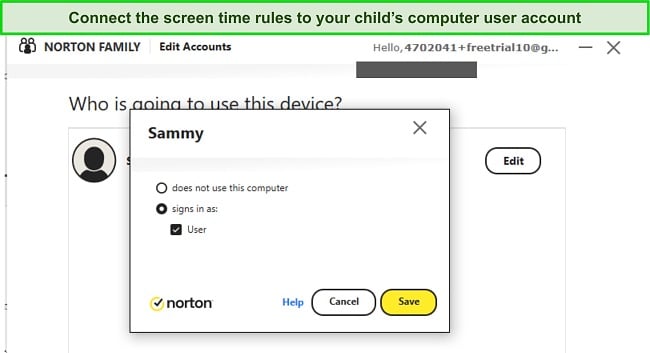
Norton Family has a default screen time schedule based on a child’s age, but I preferred creating a custom schedule that worked around our family’s routine. I opened the Time Supervision feature in the parental dashboard, and had two options:
- A daily screen time limit.
- A schedule for when the computer is available.
Both the overall screen time and schedule are managed with 30-minute time blocks. I found that while it’s not as flexible as I’d like, I can certainly work with it to create reasonable rules for my son.
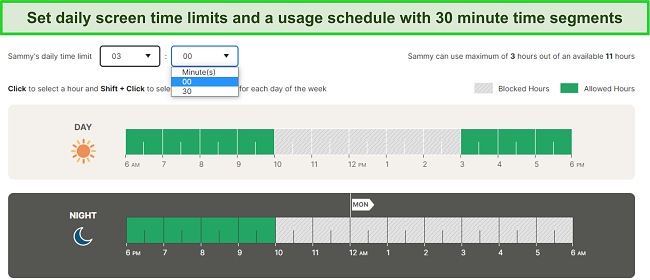
In addition to regular screen time rules, Norton Family has a special screen time feature called School Time. When it is active, most websites and programs are blocked, except those my son needs for school. Norton Family has a default list of around 30 websites that are not blocked, but it also gives me the option to add websites that my son needs for his school or homework. The screen time used when School Time is active does not count against the general screen time rules. This is important because it means that my son didn’t have to stress out that he was “wasting” screen time doing homework.

Unlike Qustodio, which gave me the option to block the internet or log my child off his account, Norton Family only offers the log off option. If that sounds like a good fit for you, you can try Norton Family risk-free for 30 days, which provides enough time to test it and set screen time limits on your Windows or Mac to observe how they impact your child’s behavior.
Try Norton Family Risk-Free for 30 Days!
3. Mobicip: Customize Rule Based Screen Time Routines
Mobicip is a reliable parental control app with a good collection of features. I installed it on my Mac to see how its screen time features work. Once I connected Mobicip to my daughter’s user profile, I was able to set up the rules.
There are two ways to limit screen time. The first is a basic daily limit, which blocks the computer when the time runs out. The lock screen has three options:
- Request more time.
- Go to the child dashboard, where they can see when the Mac will unlock.
- Sign out of the user account, so another child can log in and use the computer.
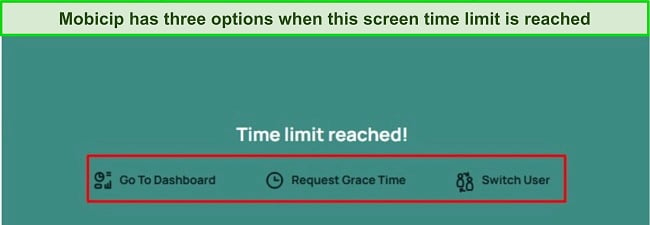
While these are good options in theory, they did provide a few ways for my daughter to bypass the rules. She could switch over to her brother’s account or access the parental rules through her dashboard and add more time. The good news is that I can see from the activity report when she adds time or engages in unusual activity on her brother’s account, and I can block the device completely if necessary.
The second option is to create a daily routine for when the computer is available and what websites or apps are accessible at that time. Mobicip comes with two default options: school and sleep.
I was able to create additional routines with unique rules. For example, I created a routine named Homework Time, and I blocked social media, online gaming, and video streaming sites. Then, I added two hours of free time, and I customized the web filter to allow any website that isn’t inappropriate.
Mobicip has a 7-day free trial, although you will need to add your credit card to activate the account. This is enough time to install the app on your kid’s computer or Mac and see how the screen time rules work for you.
Browser Extensions Can Work with Young Kids – But They’re Too Easy to Disable
I’ve installed dozens of browser extensions on Firefox and Chrome that claim to help create screen time limits. I set different screen time limits for each child profile, and initially, it seemed like it would be a good solution. The ones that worked blocked the browser when the screen time limit was reached. However, this solution is not really a good option for kids over the age of 6. It doesn’t take a tech genius to bypass or turn off the extension. My 10-year-old told me she can just use a different browser when the first one locks. Another problem I saw is that there’s no uninstallation protection with browser extensions. My teenage son just clicked on the “Manage Extension” link on Chrome and disabled the extension so he could keep playing games.
The other issue is that the screen time rules only apply to the browser, not apps or games that are installed on the computer. This is what really separates Qustodio from every other solution I tried. In addition to comprehensive screen time tools, it has a Lock Device option that logs the child off the computer until there is available screen time. Qustodio also offers a free 30 day trial, with no credit required, so you can experience the screen time tools yourself with no risk.
Keep the Windows or Mac in a Central Location in Your Home
It’s difficult to limit your child’s screen time if they’re using the computer in a remote area of the house, like their bedroom, basement, or attic. The simple fact is that if you don’t see what they’re doing, you won’t be as quick to limit what they’re doing.
From the child’s perspective, it’s easy to lose track of time when using the computer with no distractions. They can sit in front of the screen, gaming, browsing the net, streaming, watching YouTube for hours without even realizing it. By setting up the computer in a central place in the house, you’ll be conscious of how long they’ve been on the Windows or Mac and tell them it’s time to log off. They won’t be able to sneak back on because the computer is in the central location in the house. Another side benefit of this method is that they will stay away from inappropriate websites since you can walk by and see the screen at any time.
However, while this is good advice, I found 3 weaknesses:
- If you’re not home, the kids will be able to stay on the computer with no limits and go on whatever websites they want.
- It’s on you to track how long your child has been on the computer.
- This will only work with the Windows and Mac; they can always take the phone or tablet and go to another part of the house to continue their screen time.
Qustodio solves all three of these issues. Once you set the screen time limits, they’re enforced no matter where you are, and it has a web filter to block inappropriate sites. It also generates a screen time report, so you’ll know how much time your child was on the computer, without having to track or remember it for yourself. Lastly, Qustodio is compatible with computers, tablets, and phones, up to 25 devices per account, so you can create screen time rules that apply to the Windows and Mac, plus the phone and tablet.
Try Qustodio Free for 30 Days!
Make Screen Time Rules for the Entire Family
One of the most common things my kids would say to me when I tell them they spend too much time on the screen is, “you’re on the screen more than us!” I used to try and justify it to them, that I had more important things to do than whatever they were doing. Clearly, this never worked and caused lots of arguments. I realized that if I couldn’t tell my kids about the dangers of too much screen time while I was always on the computer or my phone.
We had a family meeting and created rules for the entire family to find ways to limit screen time on the Windows and Mac. Some ideas for rules include:
- No computer time during meals.
- Get off the computer 45 minutes before bedtime.
- No sitting at the computer for more than an hour straight. You must get up, stretch, walk around the house, etc. This prevents the kids from losing track of time and spending hours on the computer.
For this to work, you really need the kids to buy into the idea. Explain to them the dangers of too much screen time and encourage outdoor and social activity so they’re not just pining away for the computer.
This method worked in my house for a little bit, and we did create good screen time habits. However, it has the same limitations as keeping the computer in a central location. You have to constantly monitor your kids and track when they’re using the Windows or Mac.
This is why a premium parental control app is the best way to set screen time limits for Windows and Mac. You can create the screen time rules, whether it’s an overall daily limit or a screen time schedule, and then let the app do the rest of the work. They work 24/7, have remote control access so you can manage the screen time rules from anywhere, and the kids won’t be able to disable or bypass the rules.
Try Qustodio Free for 30 Days!
What to Look for When Choosing an App for Setting Screen Time Limits
As a parent, finding the right screen time app to help manage my child’s screen time usage can be overwhelming. With so many options available, it’s essential to consider several key factors when making a decision.
- Ease of Use: The screen time app shouldn’t be difficult to set up and manage. I look for an intuitive dashboard with clearly marked buttons or tabs, so I can quickly find the screen time rules and reports. A user-friendly app will save you time and effort in the long run.
- Customization Options: Look for an app that offers customization options, such as the ability to set different screen time limits for different devices or activities. For example, at times, I want to limit social media use but allow more time for educational apps. An app with such features helps me customize each of my children’s screen time settings to their needs and interests.
- Powerful Features That are Difficult to Bypass: No app can guarantee 100% success in preventing kids from bypassing the rules. However, a good app is one that recognizes its weaknesses and implements measures to ensure that the rules are followed. I challenge my kids to bypass the rules, so I can see what preventative measures it has to block such actions.
- Tracking and Reporting: I need an app that provides detailed tracking and reporting because it’s a critical factor in monitoring my child’s device usage. I prefer an app with real-time updates on my child’s online activities. This way, I can make adjustments to screen time rules as needed and have peace of mind knowing that my child is not overusing their device.
- Compatibility: Not all apps work with both Mac and Windows. Ensure that the app you choose is compatible with your child’s device and operating system. I looked for ones that work with both so that I can use one app to monitor all the devices in the house. It’s also a good idea to ensure it’s compatible with Android and iOS devices, so you can add your children’s phones and tablets to the account and monitor their screen time there as well.
After comprehensive tests of more than 30 parental control apps, Qustodio proved to be the best and most reliable method for setting screen time limits on Windows and Mac. It also has the best free trial offer I’ve seen, 30-days with no credit needed to activate the trial period.
FAQ
Are there any free screen time apps that work with Windows or Mac?
Can kids bypass the screen time limits?
Can I use the same app to set screen time limits for computers and phones?
Only a Premium Parental Control App Can Set Screen Time Limits for Windows and Mac
While many apps boast of being “powerful” or “comprehensive,” my testing found that most failed to deliver on these claims. After testing various parental control apps, I discovered only three that provided high-quality screen time limit controls. These apps allowed me to establish a flexible screen time schedule, remotely lock the device, and generate comprehensive reports. Of these, Qustodio stood out as the best, offering versatile tools for setting a screen time calendar, a daily limit, and app-specific limits. Moreover, it proved to be highly effective at preventing my kids from circumventing the rules and using their phones once locked.
Qustodio offers a free 30-day trial without the need for a credit card, allowing you to test its premium features at no cost.


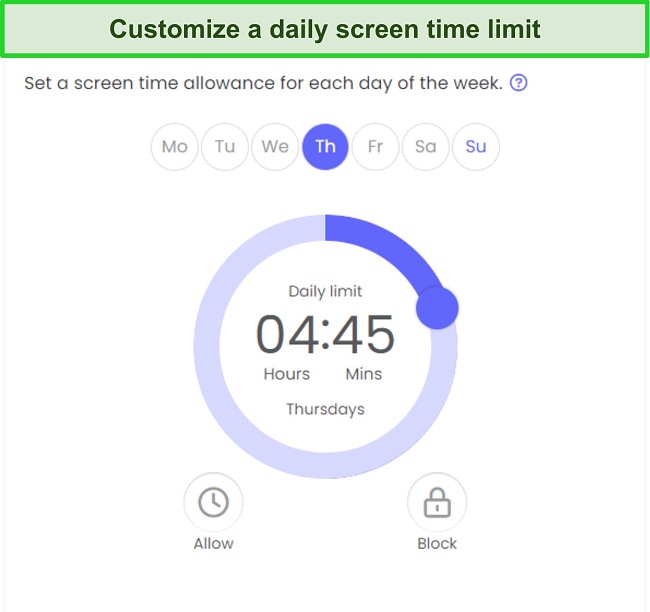
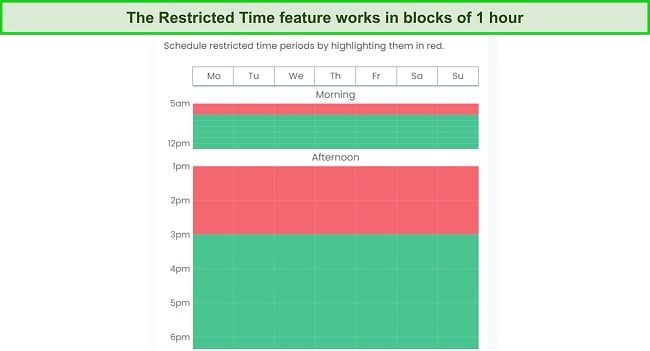
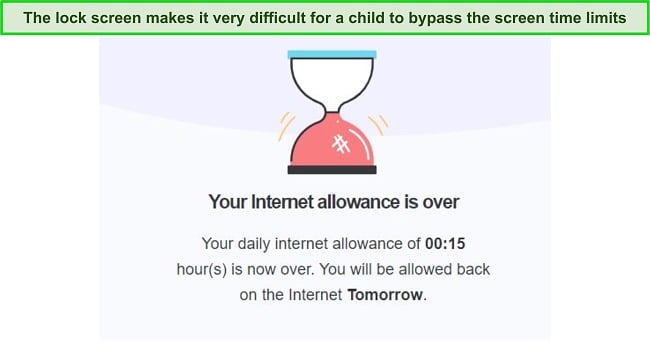




Leave a Comment
Cancel